9 days from Tangier to Marrakech
9 days tour from Tangier to Marrakech by Sahara desert. Old Rally Paris Dakar tracks and dunes. Day 1: Tangier – Azrou. Early in the morning, we will begin …
Day 1 :Tangier Tetouan Chafchaouen
Meet our guide in Tangier and drive for 3 hours to arrive chefchaouen in the Rif mountains, Set against a wide valley and nestled between two peaks in the stunning Rif Mountains, the isolated town of Chefchaouen is a surprising delight. Much of Chefchaouen was recreated by Andalusian refugees escaping the Reconquistia, so its striking blue and whitewashed houses, red-tiled roofs and artistic doorways give it the feel of the Spanish hills. After you will start exploring Chefchaouen The blue city of Morocco.

Situated at the footstep of 2 higher mountains, Chefchaouen is a beautiful unique city with its white washed walls and blue doors, and windows. Unlike many parts of Morocco, Chefchaouen was occupied by Spain; therefore there is much influence of the Spanish civilization and the Moorish architecture. On the afternoon, you will have your own time to wonder around and enjoy your space. Enjoy a free afternoon to relax or explore more of the town. Within the plaza is the walled fortress of the Kasbah – you can wander through the tranquil gardens inside, visit the ethnographic museum, and soak in wonderful views from the rooftop. Alternatively, you might prefer to get out of town and enjoy a short hike in the surrounding hills.
Day 2 : Chafchaouen_volubilis_meknes_Fes
After breakfast explore and tour Chefchaouen, the blue-washed town old medina by foot along with your guide who will share stories of Chefchaouen’s history. Start your tour with the kasbah museum in the medina. The kasbah of Chefchaouen belongs to the early 18th century, and was built by the legendary ruler Moulay Ismail. It is fairly simple without architectural surprises however it is surrounded by gardens on the interior and exterior. Inside the Kasbah, you can visit the ethnographic museum containing antique weapons, musical instruments, and photographs of the old town. Step onto the museum’s roof and take pictures of a panoramic view of the Hispanic flavored town lined with blue and white washed houses, tiny balconies, tiled roofs and patios embellished with citrus trees. Next, visit the cobbled main square, Plaza Uta el- Hammam and where the striking 15th century Grand Mosque sits.
In the evening it is possible to relax in hammam, a Moroccan spa experience. For dinner, you can dine at the Restaurant Tissemlal, a beautifully decorated old house with a French Moroccan set menu. Descend from the hills and travel south through the centre of the peninsula towards the sacred pilgrimage town of Moulay Idriss approximately 3 hours. From here it’s a short journey out to the World Heritage site of Volubilis. The remains of this Roman city make an undeniably impressive sight as they come into view on the edge of a long, high plateau. Take a tour around the arches, basilicas, and superb mosaics along the Decumanus Maximus, many of which remain intact.
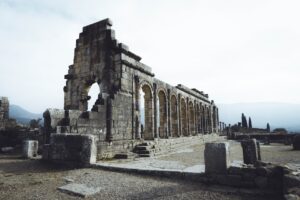
The reward for walking in the sun lies in an incredibly memorable lunch of traditional Roman recipes in the shadow of the ancient ruins. Recline on Moroccan Kilims and dine on local ingredients, much like the Romans did a thousand years ago. Once forbidden to non-Muslims, your next stop at ancient Moulay Idriss offers a great insight into traditional Moroccan life. Here the faithful gather to pay homage at the tomb of Moulay Idriss I – the great-grandson of Mohammed and the man who brought Islam to Morocco. Explore the delightful streets, perhaps sampling the famous nougat candy sold at street-side stalls. we’ll head to the lesser-visited Imperial City of Meknes. Once you meet your local expert and guide, you’ll be able to visit the famed gate of Bab El Mansour, Dar Jamai Palace, the Royal Stables, and the tomb of Moulay Ismail Continue on to Fes, arriving by evening approximately 1 hours, the spiritual heart of Morocco.
Day 3 : Explore Fes
Alawyse we begin with the entrance to the largest royal palace in Morocco. Continue with a panoramic view of the ancient medina. Enjoy an authentic experience at the traditional ceramic crafts village of Fes after that. Your next stop is Fes El Bali, the ancient town or Medina, which is a medieval part of Fes that has not changed for centuries. Optional lunch at a local restaurant. Visit the famous Al-Karaouine mosque, built by Fatima Al Fihria in 857. Al Karaouine mosque became home to the University of Al-Karaouine, which is the first university in the world and the world’s foremost center of learning at the beginning of the second millennium.
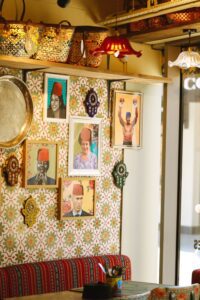
The university was built by Fatima Al Fihria in 859, and, since then, it has become one of the leading spiritual and educational centers of the Muslim world. In the medina, visit also a Merdersa, which is a Coranic school. Complete the city tour of Fes with the leather Souq and the oldest Leather Tannery in the world. The tannery dates back at least nine centuries. Fes is the spiritual and cultural heart of Morocco; vibrant, noisy, fascinating and overwhelming – a visual and pungent feast for the senses. It is made up of three distinct ‘cities’, or quarters, and you will stay in elegant, riad-style accommodation on the edge of the huge, well-preserved medieval old city – the mother of all medinas.
Today head into the old city, known locally as Fes el Bali, arguably the world’s most fascinating and confounding old city. Medieval Fes was one of the world’s great centres of education and culture, both Islamic and Jewish. Its religious institutions and libraries are legendary, its mosques of great renown. Walk through the twisting streets and alleyways, passing donkeys piled high with goods, and explore the specialty sections that divide the souk. Filled with historic khans, medresses and dye-pits, stalls loaded with fruits, herbs and soups, and where the squawk of chickens, smell of spice and sound of hammering of copper fills the air, it’s not hard to imagine yourself back in the Middle Ages. Spend the day exploring the old city, visiting, Mederassa Bou Inania, the tanneries and the splendid Funduk Nejjarine, a beautifully restored 18th century inn.
Day 4 : Fes _Ifran_Midelt_Ziz valley_Erfoud_Merzouga
Departure by road to the beautiful dunes of Merzouga, passing through Ifran known as ‘the Moroccan Switzerland’. We will stop to visit the forest of Cedros in Azrou and see the monkeys climbing the cedars. Then we will follow the route and cross the gentle mountains of the Middle Atlas, passing through Midelt and the Ziz River, and stop to take pictures of stunning panoramic views over the gorges of this river.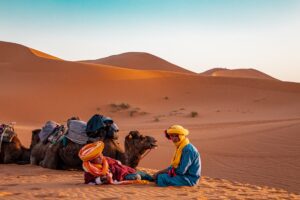
Continue to the city of Erfoud famous for the fossils that are extracted from the rocks. Arrive at the dunes of ‘Erg Chebbi’ in Merzouga, where we can feel the peace and tranquility of the desert to ride dromedaries while enjoying the sunset in the desert. An unforgettable night in the middle of the desert. dinner and accommodation in Haima Berber.
Day 5 :merzouga_todgha gorge_dades valley
Tour Around Erg Chebbi, After breakfast, we begin the drive to explore the tiny villages around Erg Chebbi dunes such as Hassi Labied, Merzouga, and Khamlia. In Hassi Labied we will stop at the garden where you will view the canal irrigation system. From here we continue on the trail toward Merzouga. Near Merzouga, you will have the chance to see Dayet Srji lake that forms in the springtime which attracts flocks of pink flamingos and wildlife, Bird-watchers will enjoy this peaceful area.
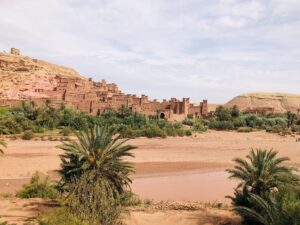
On our way to Khamlia we expect to meet locals showing their desert foxes. You may also encounter desert reptiles and mammals. In Khamlia, known as the village of black people who were once slaves from Sudan. You will be hospitably welcomed with a cup of tea (Whiskey Berber) while enjoying their spiritual Gnawa music. Leaving Khamlia, our next stop is on the panoramic view of golden dunes near the Algerian border.
We may stop for a picnic lunch under the shadow of a tree before continuing to visit a Nomad family, who live under Berber tents while taking care of the herds of cattle, goats, and camels. You will be introduced to family members and get to know about their way of life while enjoying the taste of a nice cup of tea. After this, you will have the chance to visit the sites of black volcanic rocks. Continuing on, we reach the panoramic view near Yasmina Auberge where you will be amazed at the scene of the dunes in addition to the nearby lake springtime.
Back to your hotel for lunch and relax.
Day 6 : Dades valley_rose valley_skoura valley of 100 kasbah_Ouarzazate
Visiting Errisani and the Mausoleum of the founder of the Alaouite Dynasty of Morocco, Moulay Ali Chrif in the 17th century. This silent town was the ancient capital of Tafilalet and its location as a crossroads between north and south brought the city to an important status of a former major caravan center. Up to now Rissani remains a major commercial center in the region, with a large souk, particularly lively today on Tuesdays, Thursdays and Sunday. It was noted for its leather and goat skin trading in ancient ages.
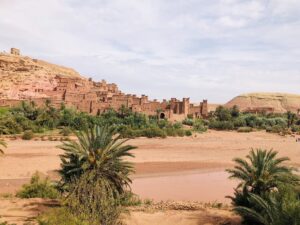
We will then visit the underground irrigation channels used by the nopmads to irrigate theire oasis of palms and henna during the drought times, we will visit the oasis Museum in one of the most vibrant valleys of southern Morocco, called the valley of Tinjdad. 127 km from Errisani the great canyons of Morocco Todgha Gorges are situated beyond the central high Atlas Mountains. Here, the contrasting landscapes remind visitors of the Colorado, with its high plateau, its gorges and great canyons, and its peaks sometimes splintered by erosion. Several peaks in this area exceed 4000 m, with Jbel Saghro 2500 m and Jbel Mgoun at 4068 m being the highest peak in this part of the High Atlas.
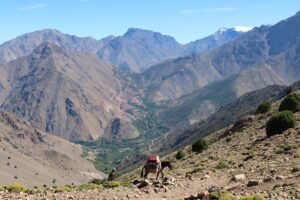
The area is populated by Berbers. Here you can enjoy a hike among those fabulous canyons. From the great canyons of Todgha we go along the road of 1000 kasbahs, since there are enormous Kasbahs on both sides of the road. Some of those old fortified houses are restored but unfortunately a lot of them are ruins. We drive up to visit the Dades gorge & valley, and we head to the Berber family for Lunch, a walk o discover the valley and spend some time wit the Berbers pass a town called Kelaat Mgouna, situated on the edge of Dades valley which rises in the High Atlas Mountains, giving life to a huge Berber community by its rich agriculture. Along this valley another valley called valley of roses appearing with the green colors of its Alfalfa plants, olive trees, fig trees and grapes. This valley gives birth to a rose from which locals produces different cosmetic products like soap, perfumes and skin creams. Locals here celebrate this rose by organizing a national festival eachend of April.
Getting to Ouarzazate Hollywood of Africa, Noiselessly town, The door of the desert, is a city situated in the middle of a bare plateau, south of the High Atlas Mountains. It is mainly inhabited by Berbers, who constructed many of the prominent kasbahs and building for which the area is known. One of those building is Taourirt Kasbah diverted in 17th century.
Day 7 : Ouarzazate_Ait ben hadou_ounila valley_tichka pass_Marrakech
Ait Ben Haddou & Ouarzazate, On this day trip to Ait Ben Haddou and Ouarzazate. You will enjoy a scenic journey into the High Atlas Mountains to the Tizi n’Tichka Pass (2,260m). Our first stop of the day is at Telouet. A village on the ‘Route of the Caravans’ from the Sahara over the Atlas Mountains to Marrakech.
Telouet has one of the most spectacular Kasbahs in the Atlas, which was once the palatial residence and headquarters of the powerful Glaoui tribe. This forgotten Kasbah holds a labyrinth of opulent rooms, maintaining a ghost of the splendor and glory of what it once beheld.
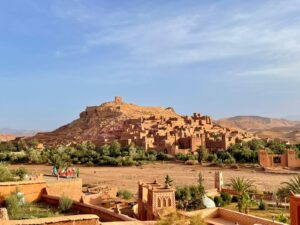
As you descend down onto the East side of Morocco you will notice a dramatic shift in the landscape changing to more arid and desert terrain.
Next, taking a little-used back road we arrive at Ait Ben Haddou. Inscribed by UNESCO in 1987 as a ‘World Heritage Site’, the Kasbah of Ait Ben Haddou is a striking example of the architecture of southern Morocco. The Kasbah, a group of earthen buildings surrounded by high walls, is a traditional pre-Saharan habitat. The houses crowd together within the defensive walls, which are reinforced by corner towers. After a guided tour of the ancient settlement be sure to walk up to the high point on the hill above the Kasbah for particularly fine views.
Day 8 :Explore Marrakech
Marrakech Walking Tour will allow you to see a number of historical areas of Marrakech and hear the stories and heritage of them.
The name Marrakech originates from the Amazigh Berber words mur (n) akush, which means “Land of God.” It is the third-largest city in Morocco after Casablanca and Rabat and lies near the foothills of the snow-capped Atlas Mountains.
The city is divided into two distinct parts: the Medina, the historical city, and the new European modern district is called Gueliz or Ville Nouvelle. The Medina is full of intertwining narrow passageways and local shops full of character. In contrast, Gueliz plays host to modern restaurants and fast food chains and big brand stores.
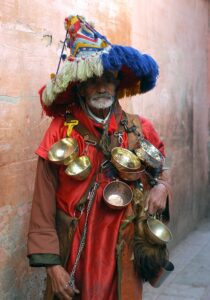
There is much to see and do in Marrakech. An entire day can be dedicated to wandering around all the different souks, seeking out the best bargains. The city also offers several historical and architectural sites as well as some interesting museums. Taking this Marrakech walking tour will give you the opportunity to see all of these without missing any out.
We’ll take you to see the monuments and palaces of Marrakech on a full-day private tour. You’ll enjoy the city’s historic gardens and the artists and entertainers at Djemaa el-Fna square and experience the exotic atmosphere of the medinas and souks. Places of interest include Djemaa El-Fna, The Souks, Koutoubia Mosque, Saadian Tombs, Dar Si Said Museum, El Bahia Palace, El Badi Palace, and The Menara Gardens.
Day 9 :free day departure
Your trip ends today with tomoroccotour.com after breakfast. We will arrange a private airport transfer you will be advised of the pick-up time. Transfer to the airport according to your flight details, Thank you for Travelling with Morocco Premium Tours and we hope you enjoyed your visit to our Beautiful Country.
What’sincluded?
- A very comfortable and air-conditioned
- Fuel for entire journey
- English speaking tour guide/chauffer during the tour(including local guides in the imperial cities) (you can specify other languages).
- Visit to Hassan2Mosque
- All nights accommodations in suite room Hotel + desert Camp
- Camel trekking
- Berber music and animation
- Dinner sand Breakfasts during the tour (vegetarian welcome) check itinerary for details.
- Daily Breakfasts.
- Marrakech, Fes, Rabat, Volubilis city sightseeing with local guides
- Pick up &drop off a tHotels /Airport.
- Authentic and unique experiences.
What’s not included?
- Flights tickets &Travel insurance.
- All Lunches, dinners (see it cinerary)
- Drinks
- Tips for your guides and driver, Porters
- Extra
- Monuments Entrances fees.
Reserve now!!!
